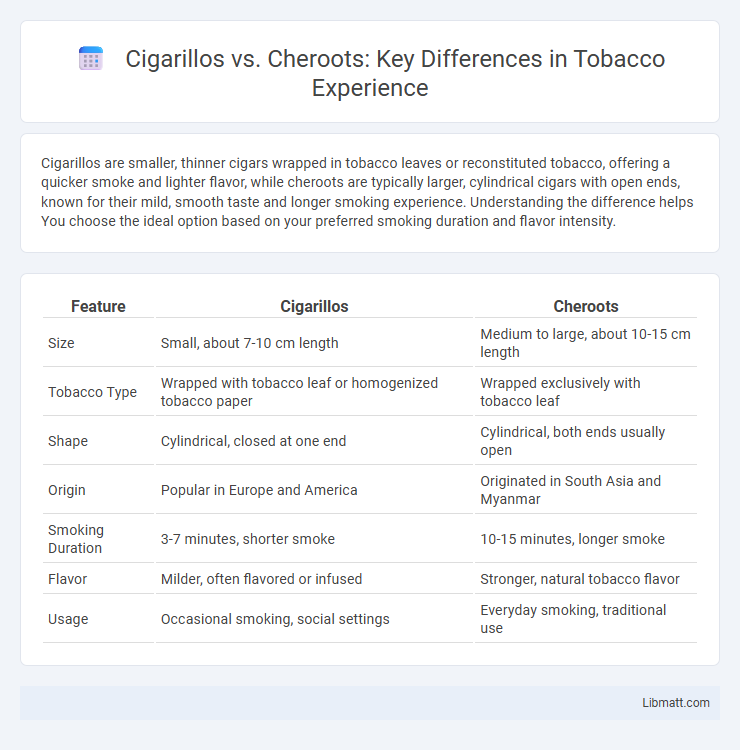Cigarillos are smaller, thinner cigars wrapped in tobacco leaves or reconstituted tobacco, offering a quicker smoke and lighter flavor, while cheroots are typically larger, cylindrical cigars with open ends, known for their mild, smooth taste and longer smoking experience. Understanding the difference helps You choose the ideal option based on your preferred smoking duration and flavor intensity.
Table of Comparison
| Feature | Cigarillos | Cheroots |
|---|---|---|
| Size | Small, about 7-10 cm length | Medium to large, about 10-15 cm length |
| Tobacco Type | Wrapped with tobacco leaf or homogenized tobacco paper | Wrapped exclusively with tobacco leaf |
| Shape | Cylindrical, closed at one end | Cylindrical, both ends usually open |
| Origin | Popular in Europe and America | Originated in South Asia and Myanmar |
| Smoking Duration | 3-7 minutes, shorter smoke | 10-15 minutes, longer smoke |
| Flavor | Milder, often flavored or infused | Stronger, natural tobacco flavor |
| Usage | Occasional smoking, social settings | Everyday smoking, traditional use |
Introduction to Cigarillos and Cheroots
Cigarillos and cheroots are two distinct types of small cigars that offer unique smoking experiences. Cigarillos are thinner, often flavored, and typically wrapped in tobacco leaves or homogenized tobacco, making them popular for quick smokes. Cheroots are larger, blunt-ended cigars without a tapered tip, traditionally handmade and preferred for their smooth, robust flavor.
Defining Cigarillos: Features and Characteristics
Cigarillos are small, narrow cigars typically wrapped in either tobacco leaf or homogenized tobacco paper, measuring between 3 to 4 inches in length and 7 to 9 mm in diameter. They are known for their quick smoking time, usually lasting 10 to 20 minutes, and are frequently flavored to enhance taste variety. Unlike cheroots, cigarillos have a tapered or closed end and often contain a blend of aromatic tobaccos designed for a smoother, richer smoking experience.
Understanding Cheroots: Origins and Traits
Cheroots originate from South Asia and are characterized by their cylindrical shape with open ends, lacking the traditional tapered tip found in cigarillos. They are typically made with dark tobacco leaves wrapped in a single, uniform leaf, which imparts a distinct, rich flavor profile compared to the smoother, milder taste of cigarillos. The traditional hand-rolled process of cheroots reflects their artisanal roots and cultural significance in regions like Myanmar and India.
Key Differences Between Cigarillos and Cheroots
Cigarillos are typically smaller, machine-made cigars wrapped in tobacco leaves or homogenized tobacco paper, offering a mild to medium flavor and shorter smoking time. Cheroots are hand-rolled, open-ended cigars often made without a wrapper leaf and usually found in regions like India and Myanmar, characterized by a robust and smoky flavor. The key differences lie in size, shape, manufacturing process, and regional popularity, influencing their taste profiles and smoking experiences.
Tobacco Blends: Cigarillos vs Cheroots
Cigarillos typically use a refined blend of high-quality tobacco leaves, combining both filler and wrapper tobaccos for a balanced flavor and smooth smoking experience. Cheroots generally consist of a simpler, often more rustic tobacco blend, with less emphasis on intricate wrapper leaves, resulting in a stronger and more robust taste. Understanding these differences in tobacco blends can help you choose the cigarillo or cheroot that best suits your personal preference and smoking style.
Production Processes Compared
Cigarillos are typically produced using high-quality tobacco leaves rolled tightly with precision machinery, ensuring consistency and a smooth draw. Cheroots involve a simpler, often handmade process, using a single tobacco leaf wrapped around the filler for a rougher texture and distinct aroma. Your choice depends on whether you prefer the refined craftsmanship of cigarillos or the rustic authenticity of cheroots.
Flavor Profiles and Smoking Experience
Cigarillos offer a rich, complex flavor profile with notes ranging from earthy and spicy to sweet and aromatic, providing a smooth and quick smoking experience ideal for brief sessions. Cheroots tend to have a milder, more uniform taste, often with subtle woody or herbal undertones, delivering a consistently calm and leisurely smoke. Your choice between these depends on whether you prefer a nuanced flavor journey or a straightforward, mellow smoking experience.
Size, Shape, and Packaging Variations
Cigarillos are typically smaller and thinner than cheroots, measuring around 3-4 inches in length with a more uniform cylindrical shape, whereas cheroots often have a slightly larger diameter and can be blunt-ended or straight-cut. Packaging for cigarillos usually includes sealed foil packs or small boxes designed to maintain freshness, while cheroots may come in bundles wrapped in paper or cellophane without individual protection. Your choice between these depends on preference for size, shape, and the convenience of packaging variations that affect freshness and portability.
Price Points and Accessibility
Cigarillos generally have lower price points and greater accessibility compared to cheroots, making them a popular choice for casual smokers. Cheroots tend to be crafted with traditional methods and higher-quality tobacco, often resulting in a higher cost and more limited availability. Your choice between these options can depend on budget and the desire for a unique smoking experience.
Which to Choose: Cigarillos or Cheroots?
Cigarillos offer a milder, more refined smoking experience with their smaller size and tightly rolled tobacco, making them ideal for quick, flavorful sessions. Cheroots provide a robust, earthy flavor with a simpler, open-ended design, often preferred by smokers seeking a traditional, full-bodied taste. Choosing between cigarillos and cheroots depends on whether you prioritize convenience and smoothness or rich, unfiltered tobacco intensity.
cigarillos vs cheroots Infographic

 libmatt.com
libmatt.com